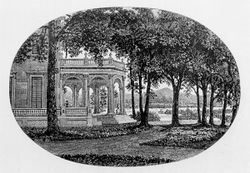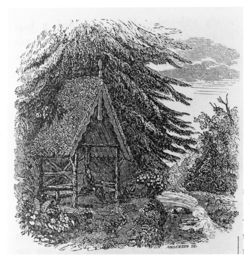Montgomery Place
[http://www.nga.gov/content/ngaweb/research/casva/research-projects.html A Project of the National Gallery of Art, Center for Advanced Study in the Visual Arts ]
Montgomery Place. . . .
Overview
Alternate Names:
Site Dates:
Site Owner(s):
Associated People:
Location:
Condition:
[View on Google maps]
History
xxx
Texts
- Downing, Andrew Jackson, October 1847, describing Montgomery Place, country home of Mrs. Edward (Louise) Livingston, Dutchess County, NY (1847: 154–160)[1]
- "About four hundred acres comprise the estate called Montgomery Place, a very large part of which is devoted to pleasure grounds and ornamental purposes. The every varied surface affords the finest scope for the numerous roads, drives and walks, with which it abounds. Even its natural boudnaries are admirable. On the west is the Hudson, broken by islands into an outline unusually varied and picturesque. On the north, it is separated from Blithewood, the adjoining seat, by a wooded valley, in the depths of which runs a broad stream, rich in waterfalls. On the south is a rich oak wood, in the centre of which is a private drive. On the east it touches the post road. Here is the entrance gate, and from it leads a long and stately avenue of trees, like the approach to an old French chateau. Halfway up its length, the lines of planted trees give place to a tall wood, and this again is succeeded by the lawn, which opens in all its stately dignity, with increased effect, after the deeper shadows of this vestibule-like wood. . . .
- "Without going into any details of the interior, we may call attention to the unique effect of the pavilion, thirty feet wide, which forms the north wing of this house. It opens from the library and drawing-room by low windows. Its ribbed roof is supported by a tasteful series of columns and arches, in the style of an Italian arcade. As it is on the north side of the dwelling, its position is always cool in summer; and this coolness is still farther increased by the abundant shade of tall old trees, whose heads cast a pleasant gloom, while their tall trunks allow the eye to feast on the rich landscape spread around it. . . . [Fig. 1]
- "THE MORNING WALK.
- "Leaving the terrace on the western front, the steps of the visitor, exploring Montgomery Place, are naturally directed towards the river bank. A path on the left of the broad lawn leads one to the fanciful rustic-gabled seat, among a growth of locusts at the bottom of the slope. Here commences a long walk, which is the favorite morning ramble of guests. . . . Half-way along this morning ramble, a rustic seat, placed on a bold little plateau, at the base of a large tree, eighty feet above the water and fenced with a rustic barrier, invites you to linger and gaze at the fascinating river landscape here presented. . . .
- "A little farther on, we reach a flight of rocky steps, leading up to the border of the lawn. At the top of these is a rustic seat with a thatched canopy, curiously built round the trunk of an aged pine. . . . [Fig. 2]
- "THE WILDERNESS.
- "Leaving the morning walk, we enter at once into 'The Wilderness.' This is a large and long wooded valley. . . . It is covered with the native growth of trees, thick, dark, and shadowy, so that once plunged in its recesses, you can easily imagine yourself in the depths of an old forest, far away from the haunts of civilization. . . .
- "But the Wilderness is by no means savage in the aspect of its beauty; on the contrary, here as elsewhere in this demesne, are evidences, in every improvement, of a fine appreciation of the natural charms of the locality. The whole of this richly wooded valley is threaded with walks, ingeniously and naturally conducted so as to penetrate to all the most interesting points; while a great variety of rustic seats, formed beneath the threes, in deep secluded thickets , by the side of the swift rushing stream, or on some inviting eminence, enables one fully to enjoy them. . . .
- "THE CATARACT.
- "But the stranger who enters the depths of this dusky wood by this route, is not long inclined to remain here. His imagination is excited by the not very distant sound of waterfalls.
- 'Above, below, aerial murmurs swell,
- From hanging wood, brown heath and bushy dell;
- A thousand gushing rells that shun the light,
- Stealing like music on the ear of night.'
- "He takes another path, passes by an airy looking rustic bridge, and plunging for a moment into the thicket, emerges again in full view of the first cataract. Coming from the solemn depths of the woods, he is astonished at the noise and volume of the stream, which here rushes in wild foam and confusion over the rocky fall, forty feet in depth. Ascending a flight of steps made in the precipitous banks of the stream, we have another view, which is scarcely less spirited and picturesque.
- "This waterfall, beautiful at all seasons, would alone be considered a sufficient attraction to give notoriety to a rural locality in most country neighborhoods. But as if nature had intended to lavish her gifts here, she has, in the course of this valley, given two other cataracts. These are all striking enough to be worthy of the pencil of the artist, and they make this valley a feast of wonders to the lovers of the picturesque. . . .
- "THE LAKE
- ". . . . The peninsula, on the north of the lake, is carpeted with the dry leaves of the thick cedars that cover it, and form so umbragous a resting place that the sky over it seems absolutely dusky at noon day. On its northern bank is a rude sofa, formed entirely of stone. Here you linger again, to wonder afresh at the novelty and beauty of the second cascade. The stream here emerges from a dark thicket, falls about twenty feet, and then rushes away on the side of the peninsula opposite the lake. . . . [Fig. 3]
- "Winding along the sides of the valley, and stretching for a good distance across its broadest part, all the while so deeply immersed however, in its umbrageous shelter, as scarcely to see the sun, or indeed to feel very certain of our whereabouts, we emerge in the neighborhood of the CONSERVATORY.
- "This a large, isolated, glazed structure, designed by MR. CATHERWOOD, to add to the scenic effect of the pleasure grounds. On its northern side are, in summer, arranged the more delicate green-house plants; and in front are groups of large Oranges, Lemons, Citrons, Cape Jasmines, Eugenias, etc., in tubs—plants remarkable for their size and beauty. Passing under neat and tasteful archways of wirework, covered with rare climbers, we enter what is properly [Fig. 4]
- "THE FLOWER GARDEN.
- "How different a scene from the deep sequestered shadows of the Wilderness! Here all is gay and smiling. Bright parterres of brilliant flowers bask in the full daylight, and rich masses of colour seem to revel in the sunshine. The walks are fancifully laid out, so as to form a tasteful whole; the beds are surrounded by low edgings of turf or box, and the whole looks like some rich oriental pattern of carpet or embroidery. In the centre of the garden stands a large vase of the Warwick pattern; others occupy the centres of parterres in the midst of its two main divisions, and at either end is a fanciful light summer-house, or pavilion, of Moresque character. The whole garden is surrounded and shut out from the lawn, by a belt of shrubbery, and above and behind this, rises, like a noble framework, the background of trees of the lawn and the Wilderness. If there is any prettier flower garden scene than this ensemble in the country, we have not yet had the good fortune to behold it. . . .
- "THE DRIVE
- "On the southern boundary is an oak wood of about fifty acres. It is totally different in character from the Wilderness on the north, and is a nearly level or slightly undulating surface, well covered with fine Oak, Chestnut, and other timber trees. Though it is laid out the DRIVE; a sylvan route as agreeable for exercise in the carriage, or on horseback, as the 'Wilderness,' or the 'Morning Walk,' is for a ramble on foot. . . .
- "Though Montgomery Place itself is old, yet a spirit ever new directs the improvements carried on within it. Among those more worthy of note, we gladly mention an arboretum, just commenced on a fine site in the pleasure grounds, set apart and thoroughly prepared for the purpose. Here a scientific arrangement of all the most beautiful hardy trees and shrubs, will interest the student, who looks upon the vegetable kingdom with a more curious eye than the ordinary observer."
Images
Other Resources
xxx
Notes
- ↑ A. J. Downing, "A Visit to Montgomery Place," Horticulturist 2, no. 4 (October 1847), view on Zotero.



